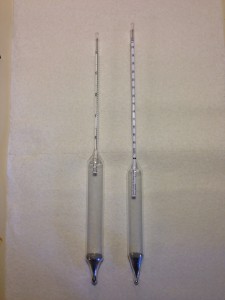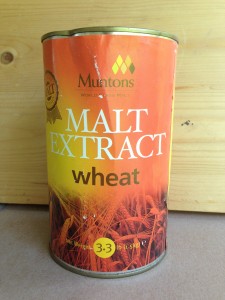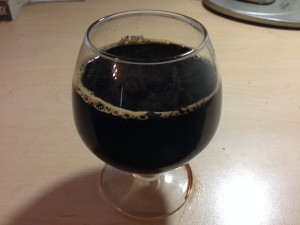 So let’s say that you’ve collected your wort, measured the wort volume and pre-boil specific gravity and, and used the “CV” equation to estimate your OG. And . . . you’re going to come in low. What do you do now? You have three main options. [Read more…]
So let’s say that you’ve collected your wort, measured the wort volume and pre-boil specific gravity and, and used the “CV” equation to estimate your OG. And . . . you’re going to come in low. What do you do now? You have three main options. [Read more…]
Hitting OG (Part 2 of 3: Low)
Russian Imperial Stout (V: Wort Production)
This is the fifth article in this series on Russian imperial stouts.
Russian imperial stouts are big beers. The BJCP gives the range of original gravities (OGs) as 1.075–1.115. In practice, most commercial examples fall in the lower half of that range. When it comes to wort production, you have several options.
BWJ Q and A (Extract Upgrade)

Thanks for the question, Russ. Here’s a picture of two cats hugging a kitten. Or maybe they’re trying to smother him. I don’t know.
I really like your articles and recipes on partial mashing, but my question is which is better, a full-wort boil using extract with steeped grains methods or using partial mash methods without boiling the full wort?
— Russell Albright (Keizer, Oregon)
Late Malt Extract Additions

Brewery-grade malt extract is made from wort that has been boiled. All that you need to do to turn it into wort is dissolve it and sanitize it. (Canned extract should already be sanitary.)
In the early days of modern homebrewing, many 5-gallon (19-L) homebrew recipes called for boiling several pounds (a few kilograms) of malt extract in as little as 1.5 gallons (5.7 L) of water for 60 minutes. This thick wort would then be diluted to 5.0 gallons (19 L) in a bucket or carboy fermenter. If you followed these instructions, you ended up with beer (and you were psyched) — but you noticed that the color was frequently much darker than a comparable commercial beer.
As the sophistication of homebrewing knowledge increased, brewers were told to address the problem by boiling larger volumes of wort. (Buying fresh extract also helped.) This helped to a degree, but homebrewers wishing to make very pale beers were often left disappointed.
In the early 2000s, homebrewers started withholding a portion of their malt extract until the end of the boil. The idea behind this was that brewery-grade malt extract was made from wort had already been boiled. It did not require the long boil that all-grain wort does to coagulate the break material. All that is required is some time exposed to heat to sanitize it. In addition, by boiling your hops in low-gravity wort — made from steeping grains and small amount of malt extract — your hop utilization would improve when compared to boiling them in a very high gravity wort. This way of brewing — sometimes called the late extract addition method — quickly became standard practice.
Although everyone does this now, new brewers may wonder why and intermediate brewers may wonder about some of the variables in the process. With that in mind, here is a rundown of adding malt extract late in the boil and how it influences the character of your beer.
Five More Tips for Extract Brewers
 Previously, I posted an article listing 5 tips for extract brewers. Believe it or not, there are other pieces of advice that may help extract brewers, and here are five more of them.
Previously, I posted an article listing 5 tips for extract brewers. Believe it or not, there are other pieces of advice that may help extract brewers, and here are five more of them.


Recent Comments